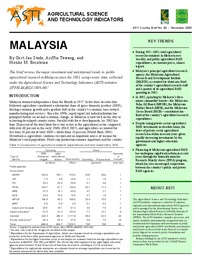Authors:
Stads, Gert-Jan; Tawang, Ariffin; Beintema, Nienke
Year:
2005
Publisher
International Food Policy Research Institute (IFPRI); and Malaysian Agricultural Research and Development Institute (MARDI)
Back to:
Although MASTIC reported that agricultural R&D accounted for only 4 percent of Malaysia’s public and private research spending in 2002 (MASTIC 2004), the sector experienced strong growth in terms of human resources and spending from 1981 until 2002. Total fte agricultural researchers rose steadily during this period, and the country’s public agricultural R&D expenditures nearly tripled over this time frame, reaching $384 million in constant 2000 prices. Agencies focusing on export plantation crops in particular reported significant increases in their total spending levels. Research spending and staffing levels at MARDI, however, showed little growth but are expected to increase in the coming years, given the institute’s aggressive recruitment drive in recent years, especially in new strategic R&D areas such as biotechnology.
The agricultural sector has been identified by the Malaysian government as one of three engines of growth for economic development. Agricultural R&D agencies—in both the public and private sectors—are expected to play a dominant role in achieving this growth. Financial support by the national government to public agricultural research is therefore expected to continue in the years to come. The government has introduced various incentives to stimulate private-sector involvement in R&D, and particularly to foster cooperation between public and private agencies.

